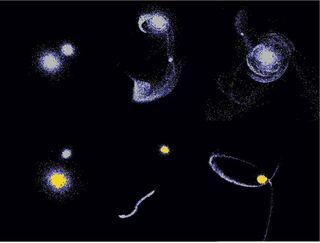How Strange, Small Galaxies Lost Their Stars

Closeencounters of the galactic kind may explain the existence of an unusual type ofdwarf galaxy, a new study suggests.
So-called dwarfspheroidal galaxies are small and very faint, containing few stars relativeto their total mass.
Thesestar-deprived galaxies appear to be made mostly of darkmatter ? an elusive form of matter detectable only by its gravitationalinfluence. Dark matter outweighs normal matter by a factor of five to one inthe universe as a whole.
Astronomershave found it difficult to explain the origin of dwarf spheroidal galaxies.
"Thesesystems are 'elves' of the early universe, and understanding how they formed isa principal goal of modern cosmology," said study author Elena D'Onghia ofthe Harvard-Smithsonian Center for Astrophysics (CfA).
Previoustheories have required that dwarf spheroidals orbit near large galaxies like theMilky Way ? but this doesn't explain how the dwarfs that have been observedin the outskirts of the "Local Group" of galaxies (which includes theMilky Way) could have formed.
D'Onghiaand her colleagues used computer simulations to examine two formation scenarios:
Get the Space.com Newsletter
Breaking space news, the latest updates on rocket launches, skywatching events and more!
- An encounter between two dwarf galaxies far from giants like the Milky Way, with the dwarf spheroidal later accreted into the Milky Way.
- An encounter between a dwarf galaxy and the forming Milky Way in the early universe.
The teamfound that the galactic encounters excite a gravitational process which theyterm "resonant stripping," leading to the removal of stars from thesmaller dwarf over the course of the interaction and transforming it into adwarf spheroidal.
"Likein a cosmic dance, the encounter triggers a gravitational resonance that stripsstars and gas from the dwarf galaxy, producing long visible tails and bridgesof stars," D'Onghia said
"Thismechanism explains the most important characteristic of dwarf spheroidals,which is that they are dark-matter dominated," said co-author GurtinaBesla, also of the CfA.
The longstreams of stars pulled off by gravitationalinteractions should be detectable. For example, the recently discoveredbridge of stars between Leo IV and Leo V, two nearby dwarf spheroidal galaxies,may have resulted from resonant stripping.
The team'sfindings were detailed in the July 30 issue of the journal Nature.
- Video: Galaxy Collisions
- Top 10 Strangest Things in Space
- New Theory Explains Mysterious Dark Galaxies
Join our Space Forums to keep talking space on the latest missions, night sky and more! And if you have a news tip, correction or comment, let us know at: community@space.com.

Space.com is the premier source of space exploration, innovation and astronomy news, chronicling (and celebrating) humanity's ongoing expansion across the final frontier. Originally founded in 1999, Space.com is, and always has been, the passion of writers and editors who are space fans and also trained journalists. Our current news team consists of Editor-in-Chief Tariq Malik; Editor Hanneke Weitering, Senior Space Writer Mike Wall; Senior Writer Meghan Bartels; Senior Writer Chelsea Gohd, Senior Writer Tereza Pultarova and Staff Writer Alexander Cox, focusing on e-commerce. Senior Producer Steve Spaleta oversees our space videos, with Diana Whitcroft as our Social Media Editor.
Most Popular


